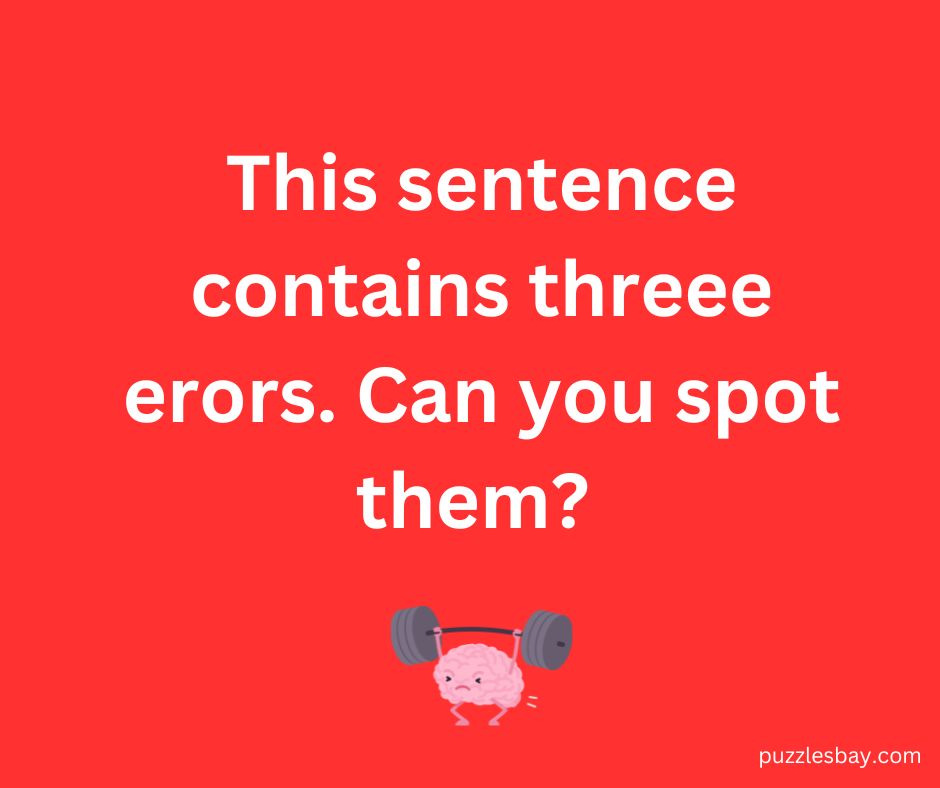
You’ve landed on this page because you’re likely looking for a solution to this tricky riddle.
Rest assured—you’re in the right place! I’ve decided to break down the answer to this puzzle, along with similar riddles, to help fellow puzzle enthusiasts who might find these types of challenges a bit puzzling.
At first glance, it might seem straightforward—just spot the three mistakes, right? But riddles like this are often crafted with a clever twist, designed to trip up even the sharpest readers.
Let’s dive into the solution and uncover the secrets behind these deceptive puzzles!
Puzzle #1: This sentence contains threee erors. Can you spot them?
The First Two Errors
The first error is likely the easiest to catch. In the word “threee,” there’s an extra “e.” One mistake down.
Then, you notice that “erors” is missing an “r,” so it should be “errors.” That’s the second mistake.
With two errors identified, we’re on a roll. Now, let’s scan for the third!
The Third Error
The real twist in this riddle—and the reason it stumps so many people—is the challenge of finding the elusive third error. So, what is the third error?
Here’s the catch: the sentence claims to contain “three” errors, but in reality, there are only two actual mistakes.
This contradiction is the third “error,” creating what’s known as a paradox.
A paradox occurs when a statement contradicts itself in a way that reveals an unexpected truth or twist, requiring us to look beyond the obvious.
In this case, the paradox lies in the fact that the third “error” is entirely different from the first two—it isn’t a spelling mistake but a misleading claim.
To spot it, you have to “step back” from analyzing each word individually and instead consider the sentence’s overall meaning.
By focusing on the statement as a whole, you realize the real error isn’t in the words themselves but in the false assertion that there are three errors.
This clever misdirection challenges you to switch off the close focus on details and grasp the message in its entirety, revealing a hidden layer to the riddle’s solution.
Related Puzzles
Puzzle #2: They are four erors in these sentence. Can you find them?
The sentence “They are four erors in these sentence” includes four errors, each designed to trick the reader.
First, “They” should be corrected to “There,” as it is the proper subject for this sentence structure.
Second, “erors” is a misspelling and should be written as “errors” with an additional “r.”
Third, “these” should be “this” to agree with the singular noun “sentence.”
Lastly, the word “four” is misleading, as it suggests the sentence initially lists four errors, when only three obvious mistakes are present.
Like in the first puzzle, the statement itself is the fourth error, making this a cleverly constructed riddle that requires close attention to both grammar and meaning.
Puzzle #3: There are are five things wrong with this sentence; only geniuses will be able to to spot all of the mitstakes
If you’ve been following along, spotting the five errors is now a breeze. They are:
- “are are” – The word “are” is repeated; one instance should be removed.
- “to to” – The word “to” is repeated; one should be removed.
- “mitstakes” – This is a misspelling; it should be “mistakes.”
- Punctuation issues – The semicolon after “sentence” is unnecessary and should be replaced with a comma for better structure. Additionally, the sentence is missing a period or full stop at the end. The corrected punctuation should read: “There are four things wrong with this sentence, and only geniuses will be able to spot all of the mistakes.”
- The fifth mistake – Just like in the previous examples, I hope you can quickly spot the fifth mistake. Can’t you? Here it is: The sentence suggests there are five errors, but there are only four actual mistakes, making the claim of “five” itself the fourth error.
Puzzle #4: How many mistakes can you spot in in the following sentence?
“This sentance contanes one misteak.“
Hopefully, solving this is now easier and more interesting. Without further ado, here are the four mistakes:
- “sentance” – This is a misspelling; it should be “sentence.”
- “contanes” – This is a misspelling; it should be “contains.”
- “misteak” – This is a misspelling; it should be “mistake.”
- The sentence claims to have “one mistake,” but there are actually three errors, so the phrase “one misteak” itself is the fourth error, as it misleads by underestimating the number of mistakes.
The Takeaway: Think Beyond the Obvious
These puzzles aren’t just about spotting typos—they serve as reminders not to take things at face value.
They challenge you to question assumptions and look beyond the surface, offering valuable lessons about perception.
So, the next time you encounter a similar puzzle or problem, remember: sometimes the answer lies as much in what’s not there as in what is.
